Share

Forest Invest
Family Office Sentiments on Forest Investment with Gabriela Leslie
Join me today as I speak with Gabriela Leslie, Senior Manager, Food, Agriculture and Natural Capital at the Creo Syndicate - a membership organization that supports its family office members to better understand the latest developments in climate investing. It creates a platform for private family investors to come together, learn from each other and collaborate on investment opportunities to solve the climate crisis. In this illuminating conversation, we dig deep on how family offices are different than institutional investors and how this shapes why they consider forest investment, how they evaluate opportunities and what is challenging the attractiveness of forest investments currently (but the outlook is positive).
“So, we find that there’s a decision-making process that comes in around, not only is this a good investment and can this scale, but you know, is the impact really meaningful?”
Host: Shauna Matkovich - The Forest Link
Producer: Magdalena Laas - https://www.linkedin.com/in/laasmagdalena/
01:25
An overview of the Creo Syndicate
02:49
The profile of family office investors compared to institutional investors
06:21
Family office capacity to evaluate forest investments
08:29
Change in family office sentiment around investing in nature and why it is attractive
12:25
Sentiments on forests versus other natural climate investment strategies
16:15
The role of carbon markets
16:58
What makes forest investment strategies challenging at the moment
19:35
Exploratory and catalytic capital into forestry
21:47
Need for more transparency in forest investment
23:52
Emerging emphasis on biodiversity
26:18
Family office approach to catalytic finance
31:42
Investment vehicles suitable for family offices
35:55
Actionable advice for forest investment managers to attract more family office capital
37:27
Links (see below)
Significant quotes:[04:41] the lack of firepower means there’s a greater premium on capital efficiency and impact.
[05:12] So we find that there’s a decision-making process that comes in around, not only is this a good investment and can this scale, but you know, is the impact really meaningful?
[08:21] Our members come to the nature space with a lot of enthusiasm. I’d say this is a market shift over the last few years. We previously had folks come to us interested in nature but not really ready to engage [...] there’s more literacy around financial markets intersecting with nature now that there ever has been.
[22:23] I think some transparency around that counterfactual piece (Improved Forest Management) would be really important in helping uplift the reputation o the sector as an impact strategy.
[27:52] So catalytic in our mind doesn’t need to be philanthropic. It just needs to be risk on, it needs to be impact first. And we see some really great examples of folks coming in and they’ll either cut the first cheque or they be the last.
Links mentioned:Creo Syndicate: https://www.creosyndicate.org/
Sound Library:- Nature by MaxKoMusic/Soundcloud
- Sopwell Woodlands and Scohaboy Bog SAC, Cloughjordan, Co Tipperary, IRELAND by wild_rumpus/Soundcloud
More episodes
View all episodes

29. Rethinking Risk and Value in Forest Landscape Restoration - with Luís Neves Silva and Andrew Heald
40:08||Season 1, Ep. 29Show notesToday, Luís Neves Silva, CEO and Andrew Heald, COO of iNovaland, join me. They developed a forest landscape restoration project with a unique approach. In this conversation, Luís and Andrew tell me how they met through the New Generation Plantations platform and wanted to transform the insights shared through this group into one of implementation on the ground. Their forest landscape restoration model came from their experience in the forest sector and strong networks in the project areas. Andrew and Luis describe their cornerstone projects in Brazil and Ghana, give insights into why they are different, and urge investors to think about risk and value in other ways to achieve real forest resilience and a more sustainable economic model.QuotesIf we have the people living in the landscape as our key stewards of our programmes, then our projects, they are robust and resilient. We would like to think that our forests there will mature, storing a lot of carbon, being rich in biodiversity, and contributing to the wealth of the people living in that landscape. - LuísIn a rapidly changing climate, any investor needs to be - and looking at nature-based solutions or growing timber or food - you need to be comfortable with that level of risk and understadn how your investment and actions can reduce that risk and increase value. - AndrewImportant linksiNovalandAndrew Heald LinkedInLuís Neves SilvaFavourite trees: Cork (Quercus suber), Douglas fir (Pseudotsuga menziesii)Production teamHost: Shauna Matkovich - The ForestLinkProducer and editor: Magdalena Laas - Unscripted CreativesDetails01:20Luís professional background02:18Andrew's professional background04:20How is iNovaland different?06:23iNovaland's evolution, growth, structure & projects09:47Services - project developer13:28Brazil project17:12Ghana project19:07Desired outcomes20:30Investor profile - interested in broader outcomes, incl. social, biodiversity, carbon22:00Project focus - forest restoration23:05Resilience of investment/landscapes24:00Progression of cycles - added dimensions27:19Ability to attract new investors - local communities central to development of projects30.13Ecosystems service systems tied to projects31:18Complexity in levels of engagement with stakeholders in both programmes33:16Future of iNovaland34:43Replication of projects36:32Advice39:30Contact details Sound libraryNature by MaxKoMusic/SoundcloudSopwell Woodlands and Scohaboy Bog SAC, Cloughjordan, Co Tipperary, IRELAND by wild_rumpus/Soundcloud
28. Global Systems Change through Forest Investment with David Brand
30:41||Season 1, Ep. 28Show notesIn today's conversation, I'm delighted to be joined by David Brand, Executive Chair of New Forests and Independent Chair of the International Sustainable Forestry Coalition. In this chat, we discuss New Forests' incredible growth story and the vision that the company has been able to hold on to since its humble beginnings in 2005. We discuss David's advocacy work for forest investment, and in addition to outlining what inspires him about the sector, he shares what most frustrates him. David also introduces the International Sustainable Forestry Coalition, why it was created, and how its members work towards systemic change in the forest sector amidst the world's biggest circular bioeconomy, climate, and nature opportunity.QuotesBeing sustainable could deliver higher returns.There are tremendous opportunities here in terms of long-term sustainable, commodity markets, arrising bio-economy opportunity, where we can effectively substitute anything made out of fossil fuels with a tree.Important linksNew ForestsInternational Sustainable Forestry Coalition (ISFC)Forest Climate Solutions FundFavourite trees: Eastern white pine (Pinus strobus), Douglas Fir (Pseudotsuga menziesii), EucalyptusProduction teamHost: Shauna Matkovich - The ForestLinkProducer and editor: Magdalena Laas - Unscripted CreativesDetails03:48History and growth of New Forests as a company and focus on sustainability10:18Landscape and forest fund11:41External shareholders/investors - including Mitsui investors (2016) and Nomura - the transition/growth of the company15:40Impact - the sustainability aspect remains the driving force with new leadership 16:42Successes of New Forests - "never compromised our vision"18:49Advocacy & international commitments20:09Future opportunities/partnerships22:32Frustrations re. forest investment sector24:26International Sustainable Forestry Coalition (ISFC) - nature-positive capital/assets & long-term ROI28:03Next for ISFC - circular bio-economy transition 29:44Advice30:10Contact detailsSound libraryNature by MaxKoMusic/SoundcloudSopwell Woodlands and Scohaboy Bog SAC, Cloughjordan, Co Tipperary, IRELAND by wild_rumpus/Soundcloud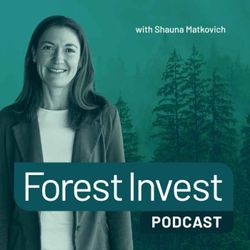
27. The Climate and Nature Tech Race with Romain Fau
31:26||Season 1, Ep. 27Show notesToday, I’m joined by Romain Fau, CEO and Co-Founder of Kanop, a climate tech firm supporting its clients with remote sensing data provision, analysis, validation, and so much more. In our conversation, Romain shares why he entered the climate space and Kanop’s journey to date. We explore the general upswing in climate and nature tech and provide listeners with tips for engaging with the right service providers for their needs. We also look at the specific use case for Kanop’s support with the VM0047 methodology.QuoteI would encourage a potential investor to look at the resilience of the project. Climate change has a big impact on nature, unfortunatley. And, we need to ensure what we do, where we invest, will remain here for long. Important linksKanopRomain Fau (LinkedIn)Email: romain@kanop.ioFavourite tree: Quercus alba (White oak) Production teamHost: Shauna Matkovich - The ForestLinkProducer and editor: Magdalena Laas - Unscripted CreativesDetails01:19Romain's professional background and overview of Kanop03:51Evolvement of services06:23Evaluation re. feasibility of project07:20Client profile08:34Climate & nature tech industry11:41Open-source resources14:57Provider right fit for needs17:33Kanop's strategy for nature-based projects18:37VM0047 methodology & voluntary carbon market & remote sensing data21:48Data unavailable or unusable - AI needs fewer data points24:08AI limitations - garbage in, garbage out, black-box effect, & improvements27:00Next for Kanop, e.g., supply chain monitoring, biodiversity29:31Advice30:35Contact details Sound libraryNature by MaxKoMusic/SoundcloudSopwell Woodlands and Scohaboy Bog SAC, Cloughjordan, Co Tipperary, IRELAND by wild_rumpus/Soundcloud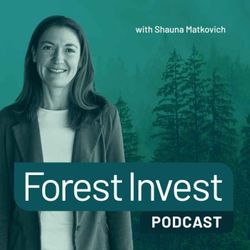
26. Investing the Spectrum of Natural Capital and Climate with Martin Berg and James Bullen
44:24||Season 1, Ep. 26Show notesJoin me today, where I speak with Martin Berg, CEO, and James Bullen, Head of forest investment at Climate Asset Management (CAM). In this conversation, Martin explains how this young asset management firm has reached a significant goal across three investment strategies, with objectives ranging from timber-driven financial returns in developed markets to high-quality carbon-credit-driven returns in developing markets. We learn about how CAM is different, where their impact focus often is a deciding factor in asset eligibility to their strategy. If you’re curious how they’re, listen to James explain three concrete examples of assets they’ve invested in across these different strategies.QuotesMartinForestry is always the first step of natural capital that investors get their head around. What we find is that it takes a long time for these investors to find the right place where they house this, so where does it sit, what allocation should we use in order to finance this, what is the risk profile? It is a relatively low risk asset class, you learn a lot by actually doing it.JamesIn terms of forestry, it is a limited resource, it is sustainable and our demand for timber and also the co-benefits that forestry bring are just going to increase. The high-quality, well-managed forests are always going to be valuable. Important linksClimate Asset Management (CMA): https://climateassetmanagement.com/Restore Africa Project: https://www.evergreening.org/restoreafrica/Production teamHost: Shauna Matkovich - The ForestLinkProducer and editor: Magdalena Laas - Unscripted CreativesDetails01:12James Bullen's and Martin Berg's professional background03:14Climate Asset Management (CMA) & climate themes/assets07:06Corporate players08:05The evolvement of investment strategy09:35One billion in commitments - two strategies: natural capital & nature-based carbon11:01Natural capital fund - investment assets13:48Investors14:12Carbon credits & impact objectives17:24Investment requirements - institutional, corporate vehicles18:24Diverse portfolio19:59Mitigation banking, reforestation, biodiversity credits21:41Asset characteristics & flexibility in opportunities in asset classes26:53Examples of why some assets do not fit into strategy28:31The challenge to originate pipeline for deals29:55Target for agriculture exposure vs. forestry31:41Challenge of emerging markets, generating investment interest34:02Carbon projects, timber components, greenfield establishment of forests in emerging markets35:27Concrete examples of strategies - agricultural, forestry, biodiversity/regenerative/carbon credits38:51Restore Africa project04:21Land management and environmental impact41:59AdviceSound libraryNature by MaxKoMusic/SoundcloudSopwell Woodlands and Scohaboy Bog SAC, Cloughjordan, Co Tipperary, IRELAND by wild_rumpus/Soundcloud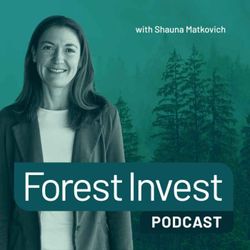
25. Rethinking how we Finance Forest Landscapes with Tony Simons
52:49||Season 1, Ep. 25Show notesJoin me today, where I speak to Tony Simons, Senior Fellow of UNCCD G20 Initiative and CIFOR/ICRAF. His wealth of experience shines through in this conversation, where he describes the Managalas project, in Papua New Guinea, a country with more than 90% forest cover where 97% of the land is community held. The project truly connects how conservation meets community needs. Though carbon is a piece of the puzzle, Tony explains how valuing such a project on carbon alone is a false representation of the value these forests deliver. We discuss the financing mechanism and multi-stakeholder involvement behind this project and much more. QuotesAnd so the big problem for forest conservation is that forests and forest protection has been equated to carbon and it's so wrong. I mean, we would not allow it or stand for it in any other sector or domain.We want the benefits from forestry at a local level for the communities at a national level in terms of sovereignty and responsibility and at a global level. And we've just hidden those benefits from humanity. And if we really value forests and we think, well, you know, forests were these things created 380 million years ago when CO2 was 4000 parts per million, 10 times what it is today. And it brought down the world's temperature by 10 degrees. Important linksTony Simons LinkedIn: https://www.linkedin.com/in/tony-simons-359b09b/Center for International Forestry Research and World Agroforestry (CIFOR-ICRAF): https://www.cifor-icraf.org/Global Canopy: https://globalcanopy.org/The Managalas Project: https://themanagalasproject.com/Favourite trees: Guaiacum sanctum, Mangifera indica (mango tree), Quercus robur (oak tree)Production teamHost: Shauna Matkovich from The ForestLinkProducer and editor: Magdalena Laas from Unscripted CreativesDetails02:03Overview - Tony's background 05:30Greenwashing evolution12:56Papua New Guinea Managalas Project17:50Financial stakeholders - approvers, enablers, and implementers22:38Fungible value and non-fungible aspects of the project27:08Rules of engagement - corporations and communities33:31Local community trust - carbon markets - partners/funders - revenue stream38:19What's in it for corporates funding the project?43:00Key successes of the project & lessons shared 45:49Importance of land use planning & management49:00Actionable forestry investment adviceSound libraryNature by MaxKoMusic/SoundcloudSopwell Woodlands and Scohaboy Bog SAC, Cloughjordan, Co Tipperary, IRELAND by wild_rumpus/Soundcloud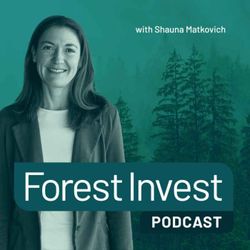
24. The State of Play for Forest Investment in 2024 with Peter D’Anieri
38:54||Season 1, Ep. 24Show notesJoin me today as Peter D’Anieri of Sewall Forestry walks us through their 2024 Forest Investors Survey results. We discuss discount rates across different US forest investment jurisdictions and beyond to more than 40 other geographic/market-oriented regions. We also talk about the contemporary topics of climate and carbon, interest rates, and much more. This is a must-listen episode if you want to get up to speed quickly on investor sentiment across the asset class.QuoteRecognise that as an investment force, forests are unique because they're a growing asset whose investment attributes are relatively unrelated to, to all other asset classes that people conventionally invest in. Forests are a moderate return risk efficient asset when looked at from an investment perspective, and therefore they deserve to be treated like a core asset in a portfolio.Important linksSewell Forestry: https://www.sewallforestry.com/Favourite tree: Acer saccharum (sugar maple)Production teamHost: Shauna Matkovich from The ForestLinkProducer and editor: Magdalena Laas from Unscripted CreativesDetails01:41Background to Sewell and Peter03:37Investment trends in 2024, e.g., discount rates05:57Discount rate required for traditional timberland in the US06:59Major US regions and regional discount rate differential10:27Factors that can impact discount rates, including carbon agreements12:07Carbon agreements objectives13:20The difference in ESG definitions and questioning on the survey17:07Results re. ESG, sustainability and returns17:57Impact forestry investment themes18:46Surprises in results20:48Climate change risks - concerns from respondents & adjustments23:19Rising interest rate environment26:17Other jurisdictions - appetite for forest investment27:27Expansions - Australia, Chile, US29:08Compressions?31:27Generalisations re. how do these regions compare to the base US discount rate?34:24Question on the survey: do carbon projects reduce the incentives for traditional forestry?35:39Actionable advice36:44Contact detailsSound libraryNature by MaxKoMusic/SoundcloudSopwell Woodlands and Scohaboy Bog SAC, Cloughjordan, Co Tipperary, IRELAND by wild_rumpus/Soundcloud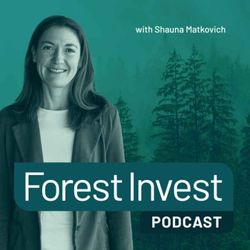
23. Achieving a Quadruple Bottom Line from Indigenous Engagement with Domenico Iannidinardo
22:30||Season 1, Ep. 23In this week’s episode, I speak with Domenico Iannidinardo, CEO of Strategic Natural Resource Consultants. In this conversation, Domenico and I reminisce about our shared history in a natural resource dependent town and how things have come to change (for the better) with respect to recognition of Indigenous Rights. We talk about how Strategic’s recently new ownership model, majority owned by the Ehattesaht First Nation is giving rise to Indigenous leadership in decision-making, integrating First Nations values in how the business is run and opening up new business opportunities for Strategic."Our Indigenous stakeholders know as much as anyone about perseverance and sustainability; they are the descendants of rich and respected cultures that know how to integrate strategy and vision into everyday decisions. And it takes time." Produced byHost: Shauna Matkovich - The Forest LinkProducer: Magdalena Laas - https://www.linkedin.com/in/laasmagdalena/Important linksStrategic Natural Resource Consultants Inc (SNRC): https://snrc.ca/Favourite tree: Yellow cedarDetails02:19Domenico's background05:08Overview of Strategic Natural Resource Consultants07:48How to integrate Indigenous involvement and advocacy10:19First Nations included at the highest strategic levels11:53Cultural awareness and training12:35Measure cultural line as a corporation13:31Board composition15:40Chief Simon John on native ownership and strategic decision-making17:22Indigenous leadership model18:55Expansion moving forward21:23Actionable advice22:05Contact detailsSound libraryNature by MaxKoMusic/SoundcloudSopwell Woodlands and Scohaboy Bog SAC, Cloughjordan, Co Tipperary, IRELAND by wild_rumpus/Soundcloud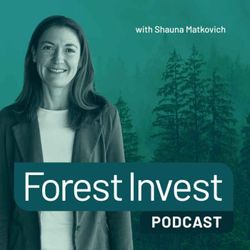
22. The Mindset behind Impact Forestry with MaryKate Bullen and Juan Pablo Lankenau Haas
51:02||Season 1, Ep. 22In today’s conversation, I’m joined by MaryKate Bullen and Juan Pablo Lankenau of Forest Investment Associates. We discuss FIA’s journey and how the organization’s investing and forest management approach have evolved over the years. Where ensuring sustainable forest management and fiduciary duty remain paramount – the company is finding new ways to bring climate and nature objectives ‘to the front seat’ in what they do. We talk about the mindset shift behind this evolution and the opportunities that are emerging.QuoteJuan Pablo: "This is a very active asset class that requires hands-on work. Our products, which are seedlings, logs, and fertilizer, are very physical, clunky, heavy, and expensive to transport, right? So, making sure to understand all of those dynamics and how they exist in the real world is critical for any newcomer who is thinking about investing in our asset class."MaryKate: "Don't lose sight through the complexity and confusion and the headlines of the real potential that exists with those real assets"Show notesHost: Shauna Matkovich - The Forest LinkProducer: Magdalena Laas - https://www.linkedin.com/in/laasmagdalena/Important linksForest Investment Associates (FIA): https://www.forestinvest.com/Favourite trees: California Redwood & Araucaria araucana (Monkey Puzzle)Register for the Theory of Change Webinar: Theory of Change WebinarDetails03:04FIA's investment and forest management philosophy06:13FIA's business culture08:05FIA's geographical expansion and approach14:29Impact forestry investment - what is it?18:48Aspects of driving the mind-shift towards ESG & responsible investment23:21Forestry and climate change challenge/Sustainable forest management28:35Biases (Juan Pablo)32:35Change in approach to due diligence and supply chain42:33Biases (MaryKate)45:00Success stories47:39Future of FIA50:37Demystify forestry investment51:44Actionable advice54:33Contact detailsSound libraryNature by MaxKoMusic/SoundcloudSopwell Woodlands and Scohaboy Bog SAC, Cloughjordan, Co Tipperary, IRELAND by wild_rumpus/Soundcloud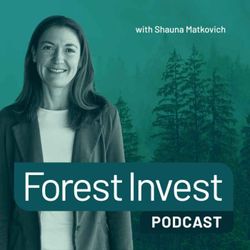
21. How Danish energy company Ørsted is owning NbS with Peter Kristensen
29:56||Season 1, Ep. 21In today's conversation, I chat with Peter Kristensen, Director, Head of Biomass Sustainability at the Danish energy company, Ørsted. Peter describes Ørsted's transition plan and how they are using nature-based solutions to abate their remaining emissions (only 2%!) after executing their ambitious Science-based targets emission reduction plan. In this conversation, we discuss why Ørsted has targeted the global south for their NbS project development, why they do everything in-house and explains some of the great projects they are supporting. Lots of boots on the ground lessons from this chat!Host: Shauna Matkovich - The ForestLinkProducer: Magdalena LaasQuotes19:05"One thing is sure: if you don't have local partners who are really committed, have the knowledge, and so on, then it is a no-go." 27:29"I would encourage people to ensure the financing that they need before they start knocking on doors. Otherwise, we'll jeopardise this whole carbon market project; I don't think anyone will benefit."Important LinksPeter Kristensen LinkedIn: https://www.linkedin.com/in/peter-k-kristensen-gcb-d-106a32/Ørsted: https://orsted.com/Favourite trees: Oak and Scots PineDetails00:58Intro to Ørsted02:55Ørsted's nature-based solutions - science-based targets (reduce emissions) & carbon projects04:24Why Global South05:32Projects09:51Design and execution standards11:22Internal and external contributors13:01Local community participation, agreement, and remuneration15:04Using, selling. retiring carbon credits16:33Run daily business and operations (system evaluation)18:01Learning curve with each project19:57Evaluate a local partner21:00Government support/legislation21:47Exit strategy24:00Extra benefits - education24:40Next steps (target of 2%)26:26Must ensure financing - actionable advice29.27Contact detailsSound LibraryNature by MaxKoMusic/SoundcloudSopwell Woodlands and Scohaboy Bog SAC, Cloughjordan, Co Tipperary, IRELAND by wild_rumpus/Soundcloud